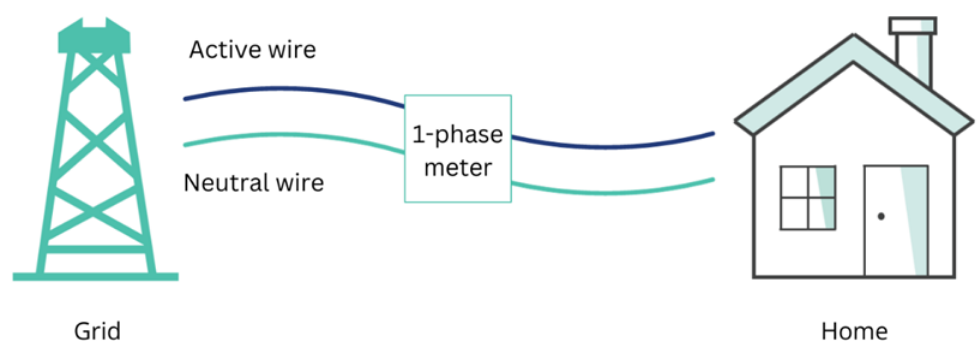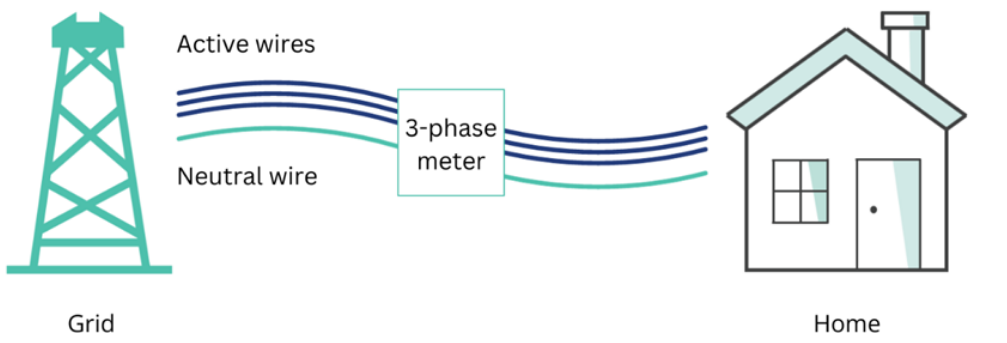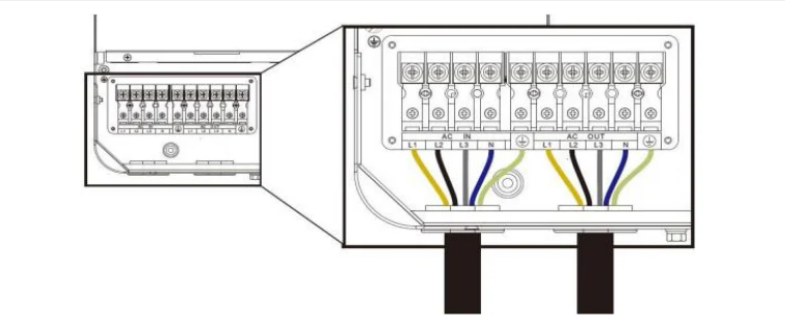
What is Three Phase Inverter?
In this tremendous global market for renewable energy, getting the most out of energy sources is crucial. One of the most dynamic innovations in the journey towards sustainable energy solutions is the three-phase inverters.
As the most recent technology discovered, three-phase inverters are still rising in popularity. So, we've written a complete guide on three-phase inverters, including how they work in solar systems, their benefits, and a lot more. Let's dive in!
Three-Phase Inverter
The three-phase inverter with the filter inductor transforms the direct current (DC) into an alternating current (AC) sinusoidal voltage through an adequate switch signal, bringing the output current into phase with the grid voltage to achieve a single power factor.
This energy conversion is achieved by means of a semiconductor switching topology in which gate signals are implemented at 60-degree intervals to the power switches, making the needed three-phase AC signal. This kind of inverter is generally employed with grid or photovoltaic modules.
Understanding of Three-Phase Supply
If you want to install a three-phase inverter in your homes and businesses, one of the first things you need to consider is whether your location has a single-phase or three-phase power supply.
Single Phase Supply
A single active wire and single neutral Wire are fed into your home if it has a single-phase supply.
Three-Phase Supply
If you have a three-phase supply, your home will have three active and one neutral wire.
Let’s know about the neutral wire and active wire;
Active Wire: This wire, also called a hot wire, carries electrical current from an energy source, such as a transformer or power station, to the electrical appliances in your home. It typically comes in multiple colors, such as green, red, or black.
Neutral Wire: A neutral wire offers a return route for the current that flows via the active wire. It fulfills the circuit and ensures the current can flow back to the power source. These are generally grey or white in electrical systems.
The main difference between the active and neutral wire is to complete the electrical circuit required to work the devices and other electrical appliances properly. Today, most homeowners rely on the three-phase energy supply due to the increase in electricity demand. They install three-phase inverters to get most of our renewable energy technology.
How Does a Three-Phase Inverter Operate in a Solar Power System?
Here, discover the working of a three-phase inverter in solar power technology to get the most out of it;
- Convert DC to AC
Generally, three-phase power consists of four wires and three servings as an additional neutral wire and active phases are connected to the switchboard.
For instance, a standard series of three-have inverters ensures an AC output across L1, L2, L3, and N with a flexible phase voltage varying from 200-240Vac. The inverter offers adjustability with a flexible line voltage between 350-415V and a default setting of 400Vac.
Such amenability advantages the three-phase and single-phase devices, making this the best fit for homes and business applications.
- Regulate DC Power from Solar Panel (DC-to-AC)
Energy storage batteries are typically deployed to fulfill the highest power demands and ensure the three-phase inverter's reliance on the grid. These batteries enable the system to work autonomously and act as a backup during power outages. To efficiently store solar energy, the three-phase inverter contributes to Maximum Power Point Tracking (MPPT) solar charge controllers.
For example, a series of three-phase inverters is integrated with an MPPT charge controller, each of which handles a range of input voltages of 200-650Vdc, with the highest solar panel input power of 6000W per channel. It ensures that the solar panels work at the highest efficiency, boosting the overall system’s output and enhancing energy harvest.
- Conversion of AC to DC
The Amazing operation of the 3-phase inverter ensures an independent power supply and allows the system to take advantage of high-demand hours to cut down electricity costs. This allows consumers to maximize the net metering benefits, specifically in industrial areas where peak demand is more pronounced.
A common three-phase inverter series accepts a phase voltage range of 170-280V and a line voltage range of 305-485V during the AC to DC conversion. In this context, a three-phase solar system supplies back the stored power to the grid during off-demand periods to earn credits.
These inverters are ideal for commercial settings to ensure a stable power supply and practical grid independence.
- Co-ordination with Grid
In these inverters, brief coordination with the electric grid indicates that accomplishing waveform, voltage, phase, and frequency is important for appropriate integration.
Advantages of Three-Phase Inverter
Here we see the following benefits of a three-phase inverter by installing it;
- Enhanced Power Density: Three-phase inverters enable the supply of balanced amperage with the smaller wires, maximizing the overall power density in the distribution system.
- Space Optimisation: Compact use of more energy in little space decreases wiring costs and delays capital expenses, helping to optimize overall space.
- Maximise Efficiency: Compared to other types of inverters, three-phase inverters offer about double the power with the equivalent current, aiming for optimized efficiency in power distribution.
- Applications: Three-phase inverters are the ideal choice for power-intensive environments such as data centers, fabrication, IT installation, warehouses, and manufacturing industries.
Bottom Line
In short, three-phase inverters are essential for managing the speed and torque of residential and commercial electrical appliances. These inverters are prominently featured in high-voltage direct current power transmission and play an important role in transforming DC power to AC in power plants and renewable energy systems for long-distance transmission.
The world is dynamically shifting towards renewable energy storage systems to get the most out of solar and wind and cut down electricity costs. Therefore, it's highly significant to source reliable energy storage solutions from authentic manufacturers. Innotinum is the top choice for residential energy solutions as they offer cutting-edge batteries and inverter systems.
Discover the wide range of energy solutions with Innotinum to address your residential energy requirements. These solutions offer not only on-grid and off-grid power access but also affordable and eco-friendly solutions.



